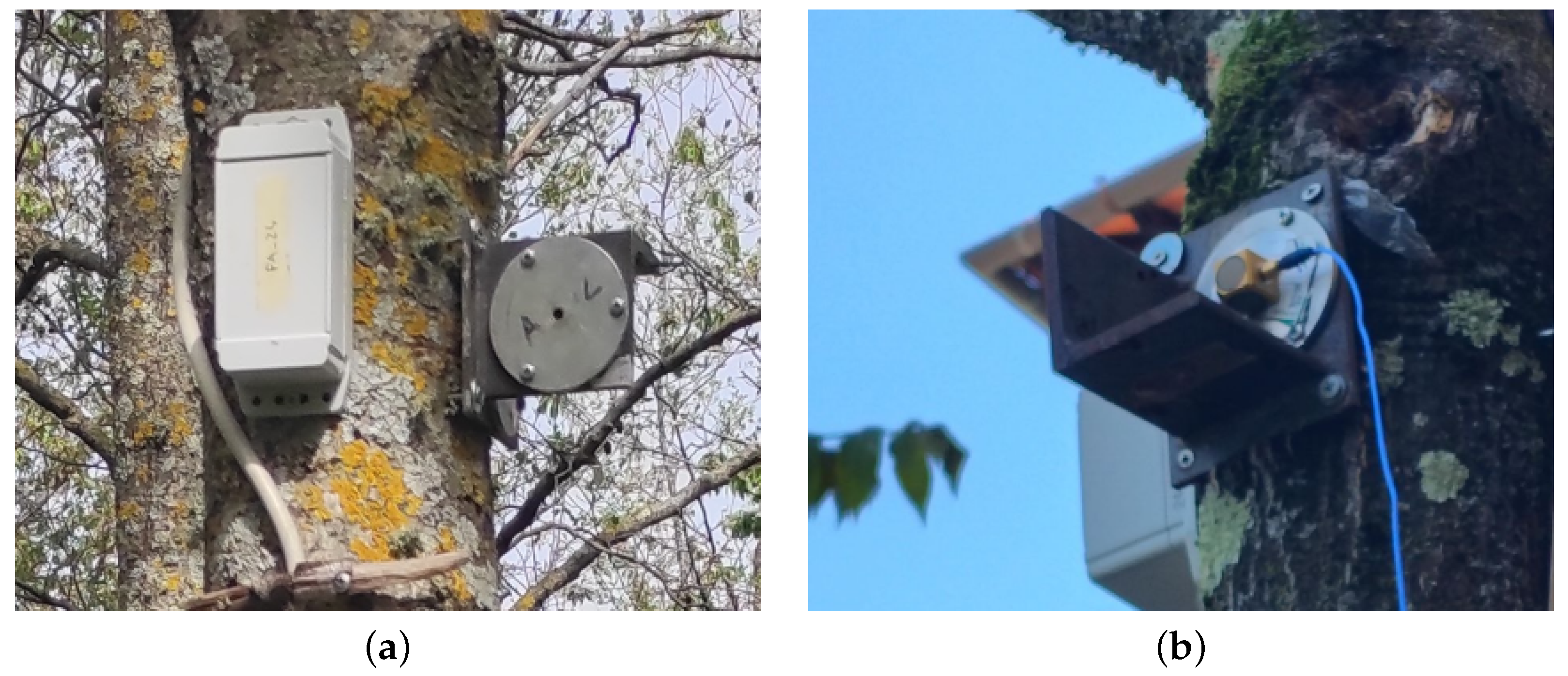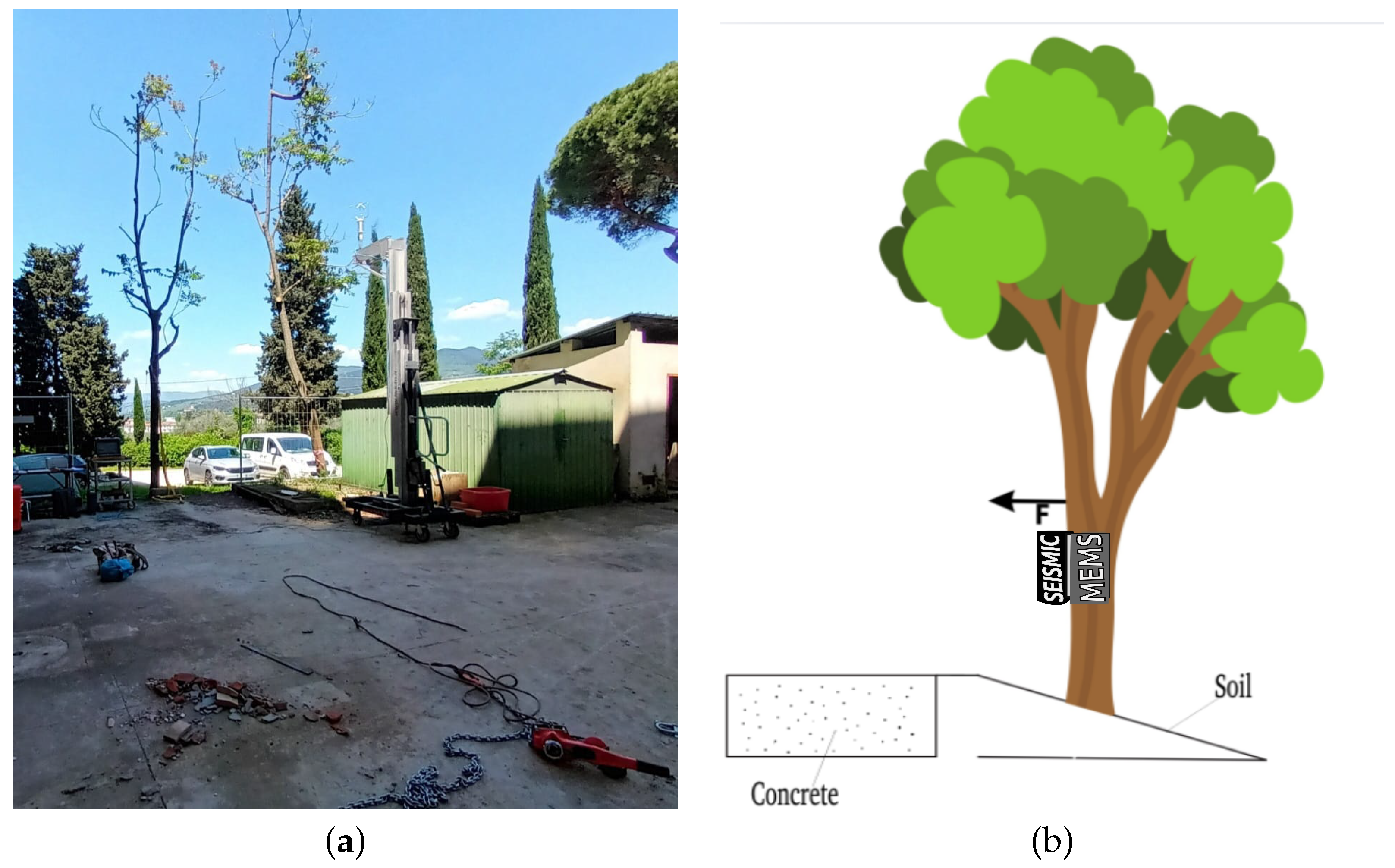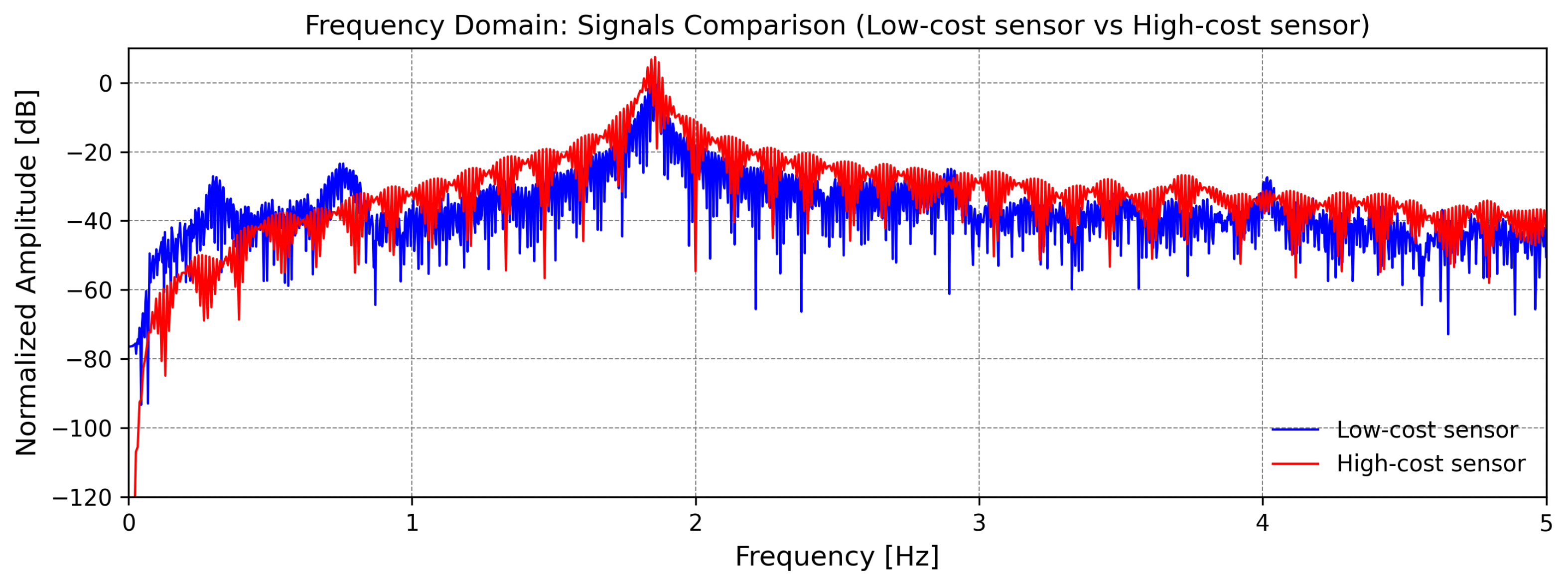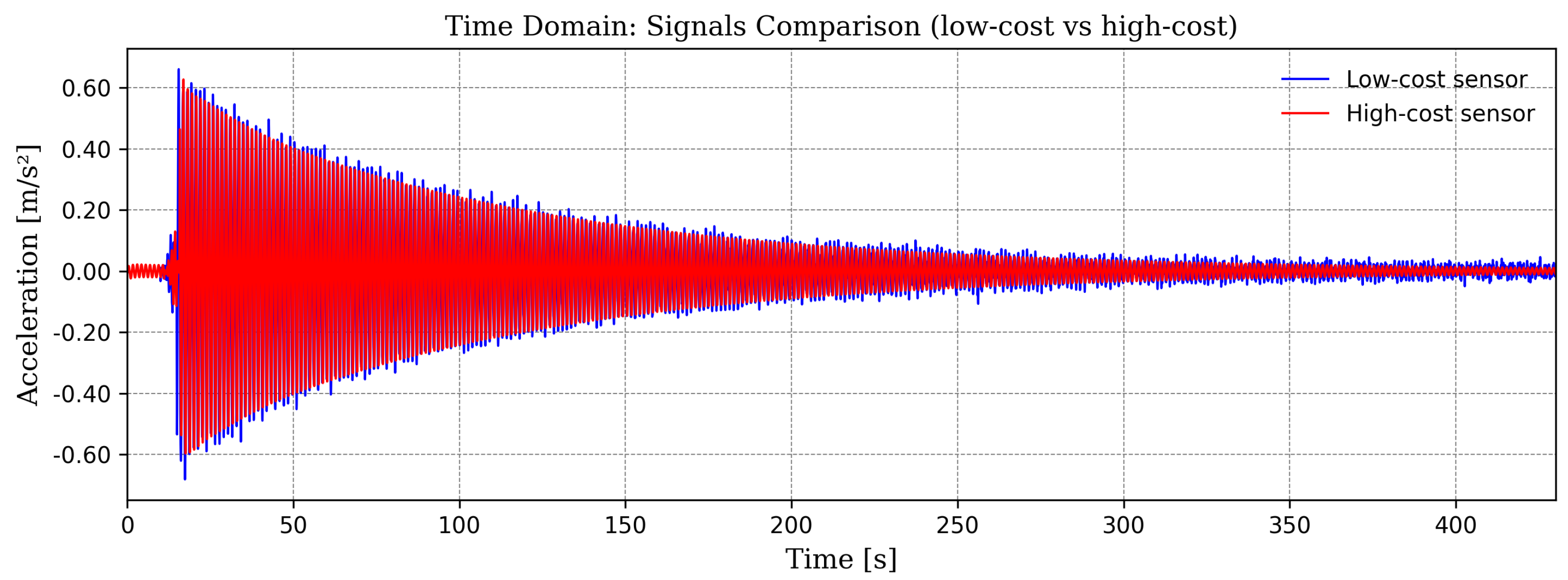Feasibility of a Low-Cost MEMS Accelerometer for Tree Dynamic Stability Analysis: A Comparative Study with Seismic Sensors
Abstract
1. Introduction
2. Materials and Methods
2.1. Sensors
2.2. Experimental Design
2.2.1. Laboratory Tests
2.2.2. Preliminary Field Tests
2.2.3. Operational Field Tests
2.3. Data Analysis
- A preliminary evaluation of the raw signals was performed in the time domain to detect potential anomalies or malfunctions.
- The signals from both sensors were processed using customized bandpass filtering strategies, adapted to the specific context. The different filter ranges were tailored to the specific conditions of each environment: the frequencies of the controlled laboratory system (the steel beam) differed from those of the trees, which were measured in a more complex and uncontrolled context. However, given the moderate size of the trees analyzed, it was confirmed that the natural frequency was not filtered out. The same filtering methodology was applied identically to all sensors, ensuring fair, reproducible, and directly comparable results across laboratory and field tests.
- Specifically, the filtering settings were as follows.
- –
- The low-cost sensor was originally sampled at 26 , and then resampled to 25 to match the target bandwidth of 0 to 12.5 .
- –
- In the laboratory tests, the bandpass filter targeted frequencies in the 0.1 to 10 range.
- –
- In the preliminary field tests, the filter focused on the 0.1 to 5 range to reduce signal noise.
- –
- In the operational field tests, the filter focused on the 0. to 9 range.
- All signals were detrended to remove linear trends that could affect the subsequent spectral analysis. Following the initial tests and the reduction of the trigger threshold, the background noise floor was evaluated to be approximately . This value was used to guide data interpretation for all subsequent tests, especially for low-amplitude signals.
3. Results
3.1. Laboratory Tests
3.2. Field Tests
3.2.1. Introduction to Field Tests
3.2.2. Preliminary Tests
3.2.3. Operational Tests
4. Discussion
5. Conclusions
Author Contributions
Funding
Institutional Review Board Statement
Informed Consent Statement
Data Availability Statement
Acknowledgments
Conflicts of Interest
References
- European Union. Three Billion Additional Trees by 2030; Publications Office of the European Union: Luxembourg, 2022; pp. 1–2. [Google Scholar] [CrossRef]
- Bottalico, F.; Travaglini, D.; Chirici, G.; Garfì, V.; Giannetti, F.; Marco, A.D.; Fares, S.; Marchetti, M.; Nocentini, S.; Paoletti, E.; et al. A spatially-explicit method to assess the dry deposition of air pollution by urban forests in the city of Florence, Italy. Urban For. Urban Green. 2017, 27, 221–234. [Google Scholar] [CrossRef]
- Ariluoma, M.; Ottelin, J.; Hautamäki, R.; Tuhkanen, E.M.; Mänttäri, M. Carbon sequestration and storage potential of urban green in residential yards: A case study from Helsinki. Urban For. Urban Green. 2021, 57, 126939. [Google Scholar] [CrossRef]
- Fletcher, D.H.; Garrett, J.K.; Thomas, A.; Fitch, A.; Cryle, P.; Shilton, S.; Jones, L. Location, Location, Location: Modelling of Noise Mitigation by Urban Woodland Shows the Benefit of Targeted Tree Planting in Cities. Sustainability 2022, 14, 7079. [Google Scholar] [CrossRef]
- Meili, N.; Manoli, G.; Burlando, P.; Carmeliet, J.; Chow, W.T.; Coutts, A.M.; Roth, M.; Velasco, E.; Vivoni, E.R.; Fatichi, S. Tree effects on urban microclimate: Diurnal, seasonal, and climatic temperature differences explained by separating radiation, evapotranspiration, and roughness effects. Urban For. Urban Green. 2021, 58, 126970. [Google Scholar] [CrossRef]
- Portoghesi, L.; Masini, E.; Tomao, A.; Agrimi, M. Could climate change and urban growth make Europeans regard urban trees as an additional source of danger? Front. For. Glob. Change 2023, 6, 1155016. [Google Scholar] [CrossRef]
- Lyytimäki, J.; Sipilä, M. Hopping on one leg—The challenge of ecosystem disservices for urban green management. Urban For. Urban Green. 2009, 8, 309–315. [Google Scholar] [CrossRef]
- Döhren, P.V.; Haase, D. Ecosystem disservices research: A review of the state of the art with a focus on cities. Ecol. Indic. 2015, 52, 490–497. [Google Scholar] [CrossRef]
- Roman, L.A.; Conway, T.M.; Eisenman, T.S.; Koeser, A.K.; Barona, C.O.; Locke, D.H.; Jenerette, G.D.; Östberg, J.; Vogt, J. Beyond ‘trees are good’: Disservices, management costs, and tradeoffs in urban forestry. Ambio 2021, 50, 615–630. [Google Scholar] [CrossRef]
- Masini, E.; Tomao, A.; Corona, P.; Fattorini, L.; Giuliarelli, D.; Portoghesi, L.; Agrimi, M. The ecosystem disservices of trees on sidewalks: A study based on a municipality urban tree inventory in Central Italy. Urban For. Urban Green. 2023, 86, 128007. [Google Scholar] [CrossRef]
- Mullaney, J.; Lucke, T.; Trueman, S.J. A review of benefits and challenges in growing street trees in paved urban environments. Landsc. Urban Plan. 2015, 134, 157–166. [Google Scholar] [CrossRef]
- Peltola, H.; Kellomäki, S.; Hassinen, A.; Granander, M. Mechanical stability of Scots pine, Norway spruce and birch: An analysis of tree-pulling experiments in Finland. For. Ecol. Manag. 2000, 135, 143–153. [Google Scholar] [CrossRef]
- Flepp, G.; Robyr, R.; Scotti, R.; Giadrossich, F.; Conedera, M.; Vacchiano, G.; Fischer, C.; Ammann, P.; May, D.; Schwarz, M. Temporal dynamics of root reinforcement in European spruce forests. Forests 2021, 12, 815. [Google Scholar] [CrossRef]
- Lüttge, U.; Buckeridge, M. Trees: Structure and function and the challenges of urbanization. Trees Struct. Funct. 2023, 37, 9. [Google Scholar] [CrossRef]
- Egerer, M.; Schmack, J.M.; Vega, K.; Barona, C.O.; Raum, S. The challenges of urban street trees and how to overcome them. Front. Sustain. Cities 2024, 6, 1394056. [Google Scholar] [CrossRef]
- Mattheck, C.; Breloer, H. Field guide for visual tree assessment (Vta). Arboric. J. 1994, 18, 1–23. [Google Scholar] [CrossRef]
- Koeser, A.K.; Hauer, R.J.; Miesbauer, J.W.; Peterson, W. Municipal tree risk assessment in the United States: Findings from a comprehensive survey of urban forest management. Arboric. J. 2016, 38, 218–229. [Google Scholar] [CrossRef]
- Yang, Z.; Hui, K.W.; Abbas, S.; Zhu, R.; Kwok, C.Y.T.; Heo, J.; Ju, S.; Wong, M.S. A review of dynamic tree behaviors: Measurement methods on tree sway, tree tilt and root-plate movement. Forests 2021, 12, 379. [Google Scholar] [CrossRef]
- James, K.; Hallam, C.; Spencer, C. Measuring tilt of tree structural root zones under static and wind loading. Agric. For. Meteorol. 2013, 168, 160–167. [Google Scholar] [CrossRef]
- de Langre, E. Effects of wind on plants. Annu. Rev. Fluid Mech. 2008, 40, 141–168. [Google Scholar] [CrossRef]
- Moulia, B.; Coutand, C.; Julien, J.L. Mechanosensitive control of plant growth: Bearing the load, sensing, transducing, and responding. Front. Plant Sci. 2015, 6, 113466. [Google Scholar] [CrossRef] [PubMed]
- Moore, J.; Maguire, D. Dynamic properties of open-grown deciduous trees. Can. J. For. Res. 2008, 41, 321–330. [Google Scholar] [CrossRef]
- Rodriguez, M.; De Langre, E.; Moulia, B. A scaling law for the effects of architecture and allometry on tree vibration modes suggests a biological tuning to modal compartmentalization. Am. J. Bot. 2008, 95, 1523–1537. [Google Scholar] [CrossRef]
- Den Hartog, J.P. Mechanical Vibrations, 4th ed.; Dover Publications: New York, NY, USA, 1961. [Google Scholar]
- James, K.R.; Haritos, N.; Ades, P.K. Mechanical stability of trees under dynamic loads. Am. J. Bot. 2006, 93, 1522–1530. [Google Scholar] [CrossRef]
- Velilla, E.; Polajnar, J.; Virant-Doberlet, M.; Commandeur, D.; Simon, R.; Cornelissen, J.H.; Ellers, J.; Halfwerk, W. Variation in plant leaf traits affects transmission and detectability of herbivore vibrational cues. Ecol. Evol. 2020, 10, 12277. [Google Scholar] [CrossRef]
- Xuan, Y.; Xu, L.; Liu, G.; Zhou, J. The Potential Influence of Tree Crown Structure on the Ginkgo Harvest. Forests 2021, 12, 366. [Google Scholar] [CrossRef]
- Loong, C.N.; Dimitrakopoulos, E.G. Modal properties of fractal sympodial trees: Insights and analytical solutions using a group tree modeling approach. Appl. Math. Model. 2023, 114, 617–628. [Google Scholar] [CrossRef]
- Gardiner, B.; Berry, P.; Moulia, B. Review: Wind impacts on plant growth, mechanics and damage. Plant Sci. 2016, 245, 94–118. [Google Scholar] [CrossRef] [PubMed]
- Fournier, M.; Dlouhá, J.; Jaouen, G.; Almeras, T. Integrative biomechanics for tree ecology: Beyond wood density and strength. J. Exp. Bot. 2013, 64, 4793–4815. [Google Scholar] [CrossRef] [PubMed]
- Kolbe, S.; Schindler, D. TreeMMoSys: A low cost sensor network to measure wind-induced tree response. HardwareX 2021, 9, e00180. [Google Scholar] [CrossRef]
- Mayer, H. Wind-induced tree sways. Trees 1987, 1, 195–206. [Google Scholar] [CrossRef]
- Sellier, D.; Brunet, Y.; Fourcaud, T. A numerical model of tree aerodynamic response to a turbulent airflow. Forestry 2008, 81, 279–297. [Google Scholar] [CrossRef]
- Van Emmerik, T.; Steele-Dunne, S.; Hut, R.; Gentine, P.; Guerin, M.; Oliveira, R.S.; Wagner, J.; Selker, J.; Van De Giesen, N. Measuring tree properties and responses using low-cost accelerometers. Sensors 2017, 17, 1098. [Google Scholar] [CrossRef] [PubMed]
- Schindler, D. Responses of Scots pine trees to dynamic wind loading. Agric. For. Meteorol. 2008, 148, 1733–1742. [Google Scholar] [CrossRef]
- Wessolly, L. Stability of Trees: Explanation of the Tipping Process. Stadt Und Grun 1996, 4, 268–272. [Google Scholar]
- Moore, J.R.; Maguire, D.A. Natural sway frequencies and damping ratios of trees: Concepts, review and synthesis of previous studies. Trees Struct. Funct. 2004, 18, 195–203. [Google Scholar] [CrossRef]
- Giachetti, A.; Zini, G.; Giambastiani, Y.; Bartoli, G. Field Measurements of Tree Dynamics with Accelerometers. Forests 2022, 13, 1243. [Google Scholar] [CrossRef]
- Chau, W.Y.; Loong, C.N.; Wang, Y.H.; Chiu, S.W.; Tan, T.J.; Wu, J.; Leung, M.L.; Tan, P.S.; Ooi, G.L. Understanding the dynamic properties of trees using the motions constructed from multi-beam flash light detection and ranging measurements. J. R. Soc. Interface 2022, 19, 20220319. [Google Scholar] [CrossRef]
- Zanotto, F.; Marchi, L.; Grigolato, S. Wind-tree interaction: Technologies, measurement systems for tree motion studies and future trends. Biosyst. Eng. 2024, 237, 128–141. [Google Scholar] [CrossRef]









| Category | Test Name |
|---|---|
| Laboratory tests | Test LAB-1: free vibration without added mass |
| Test LAB-2: free vibration with added mass | |
| Preliminary tests | Preliminary Test 1: ambient vibration—wind induced |
| Preliminary Test 2: mechanical impulse by manual impact | |
| Preliminary Test 3: pull-and-release (pulling direction: North) | |
| Preliminary Test 4: impulse excitation on ground-mounted plate with hammer | |
| Preliminary Test 5: pull-and-release by manual action (pulling direction: North) | |
| Preliminary Test 6: pull-and-release (pulling direction: North) | |
| Preliminary Test 7: pull-and-release — 491 N mass (pulling direction: East) | |
| Preliminary Test 8: pull-and-release—491 N mass (pulling direction: East) | |
| Preliminary Test 9: pull-and-release—392 N mass (pulling direction: East) | |
| Preliminary Test 10: pull-and-release—491 N mass (pulling direction: East) | |
| Operational field tests | Test B—pull-and-release—200 N |
| Test C—pull-and-release—400 N | |
| Test D—pull-and-release—600 N | |
| Test E—pull-and-release—800 N | |
| Test F—pull-and-release—1000 N | |
| Test G—pull-and-release—1200 N |
| Test | Frequency [Hz] | Damping [–] | Amplitude Mean [m s−2] | |||
|---|---|---|---|---|---|---|
| Low-Cost | High-Cost | Low-Cost | High-Cost | Low-Cost | High-Cost | |
| Test LAB-1 | 1.79 | 1.77 | 0.074 | 0.061 | 0.83 | 0.99 |
| Test LAB-2 | 0.74 | 0.74 | 0.068 | 0.015 | 0.59 | 0.57 |
| Test B—200 N | 4.91 | 4.57 | 0.136 | 0.088 | 0.28 | 0.50 |
| Test C—400 N | 3.75 | 4.81 | 0.047 | 0.063 | 1.12 | 0.75 |
| Test D—600 N | 3.65 | 4.01 | 0.157 | 0.068 | 2.15 | 1.45 |
| Test E—800 N | 3.87 | 3.96 | 0.068 | 0.074 | 1.95 | 1.71 |
| Test F—1000 N | 4.58 | 3.99 | 0.094 | 0.065 | 1.70 | 2.42 |
| Test G—1200 N | 3.87 | 4.03 | 0.025 | 0.076 | 4.14 | 3.04 |
| Test Type | Test | RMS (m s−2) | SNR (dB) | ||
|---|---|---|---|---|---|
| Low-Cost | High-Cost | Low-Cost | High-Cost | ||
| Laboratory | Test LAB-1 | 0.369 | 0.411 | 17.18 | 38.12 |
| Test LAB-2 | 0.159 | 0.140 | 9.87 | 28.68 | |
| Pulling tests | Test B (200 N) | 0.076 | 0.071 | 3.49 | 22.74 |
| Test C (400 N) | 0.254 | 0.127 | 13.94 | 27.80 | |
| Test D (600 N) | 0.380 | 0.239 | 17.44 | 33.29 | |
| Test E (800 N) | 0.472 | 0.349 | 19.33 | 36.58 | |
| Test F (1000 N) | 0.633 | 0.492 | 21.87 | 39.57 | |
| Test G (1200 N) | 0.943 | 0.621 | 25.34 | 41.59 | |
Disclaimer/Publisher’s Note: The statements, opinions and data contained in all publications are solely those of the individual author(s) and contributor(s) and not of MDPI and/or the editor(s). MDPI and/or the editor(s) disclaim responsibility for any injury to people or property resulting from any ideas, methods, instructions or products referred to in the content. |
© 2025 by the authors. Licensee MDPI, Basel, Switzerland. This article is an open access article distributed under the terms and conditions of the Creative Commons Attribution (CC BY) license (https://creativecommons.org/licenses/by/4.0/).
Share and Cite
Incollu, I.; Giachetti, A.; Giambastiani, Y.; Corti, H.A.; Giannetti, F.; Bartoli, G.; Piredda, I.; Giadrossich, F. Feasibility of a Low-Cost MEMS Accelerometer for Tree Dynamic Stability Analysis: A Comparative Study with Seismic Sensors. Forests 2025, 16, 1572. https://doi.org/10.3390/f16101572
Incollu I, Giachetti A, Giambastiani Y, Corti HA, Giannetti F, Bartoli G, Piredda I, Giadrossich F. Feasibility of a Low-Cost MEMS Accelerometer for Tree Dynamic Stability Analysis: A Comparative Study with Seismic Sensors. Forests. 2025; 16(10):1572. https://doi.org/10.3390/f16101572
Chicago/Turabian StyleIncollu, Ilaria, Andrea Giachetti, Yamuna Giambastiani, Hervè Atsè Corti, Francesca Giannetti, Gianni Bartoli, Irene Piredda, and Filippo Giadrossich. 2025. "Feasibility of a Low-Cost MEMS Accelerometer for Tree Dynamic Stability Analysis: A Comparative Study with Seismic Sensors" Forests 16, no. 10: 1572. https://doi.org/10.3390/f16101572
APA StyleIncollu, I., Giachetti, A., Giambastiani, Y., Corti, H. A., Giannetti, F., Bartoli, G., Piredda, I., & Giadrossich, F. (2025). Feasibility of a Low-Cost MEMS Accelerometer for Tree Dynamic Stability Analysis: A Comparative Study with Seismic Sensors. Forests, 16(10), 1572. https://doi.org/10.3390/f16101572








